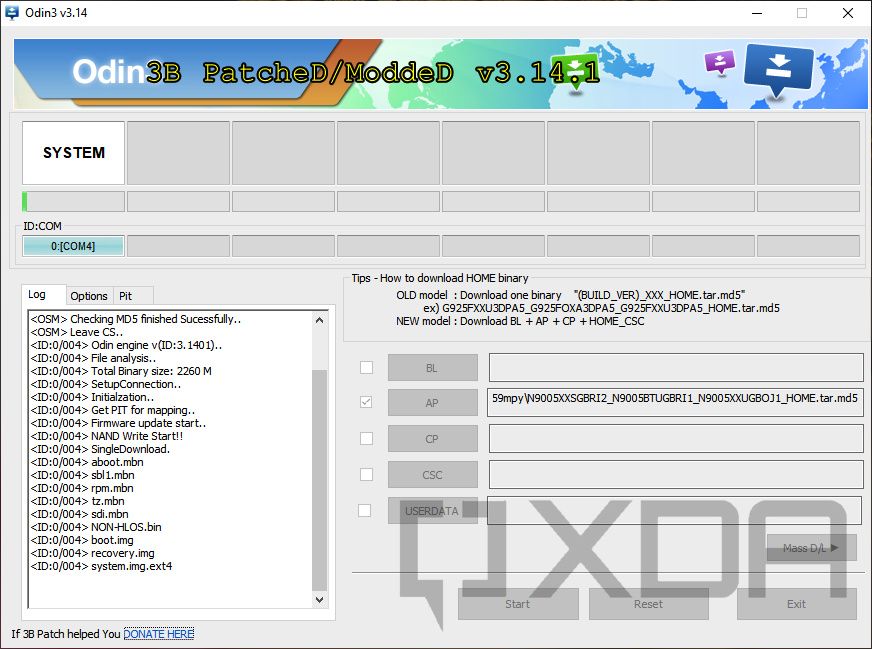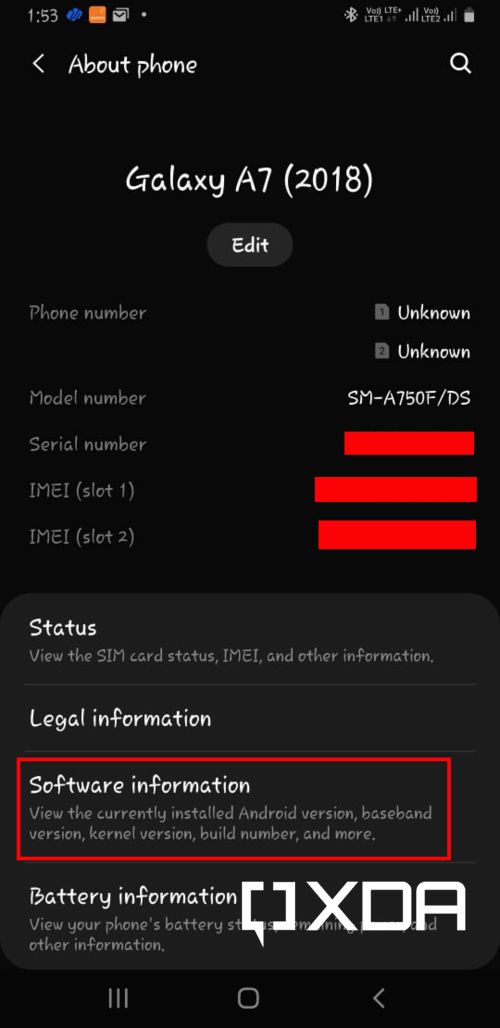
Samsung Galaxy smartphones are among the best Android smartphones in the market. When it comes to the software update front, the Korean OEM is doing a pretty decent job as well, keeping its average consumers on new and recent security patches through regular updates. However, one thing that’s not always easy to come by on Samsung Galaxy devices is the stock flashable firmware you can flash to either downgrade, upgrade, or restore your phone.
In this tutorial, we’ll show you how to manually locate the appropriate update package for your Samsung Galaxy smartphone, download it onto your PC, and finally flash the target device with the updated firmware.
Table of Contents:
- Types of Samsung firmware
- How to download Samsung firmware
- How to install Samsung firmware
- Verification
Types of Samsung firmware
Unlike most Android devices, Samsung Galaxy smartphones and tablets don’t have a true fastboot interface for firmware flashing. The Korean OEM developed their own firmware flashing tool known as “Odin”, named after the king of Gods in the Norse mythology. Odin communicates with a special software component called “Loke” which seems to be named after another important character in Norse mythology (often translated as “Loki”). Loke runs on Samsung devices while in download mode and provides the functionality necessary to perform a flashing operation.

Interface of the Odin flashing tool
Odin firmware files are like the factory images for the Google Pixel lineup, just compressed into one single archive and made easy to use via a GUI tool instead of a command line tool such as fastboot.
Samsung’s FUS (Firmware Update Server) also offers incremental as well as full OTA zip files, which are meant to be installed using the stock recovery environment.
How to download Samsung firmware
Before we get started with manual download, you should check to see if the update has already been sent to your device over-the-air. An OTA update is super easy to download and install. You’ll usually get a notification when an OTA update is available. If not, here’s how to check for the update on your Samsung Galaxy device:
- Go to Settings.
- Scroll down and tap Software update.
- Tap Download and install.
- Follow the steps to install the update if one is available. If not, it will say your phone is up to date.
If your phone reports its software is up to date, but you know an update is available for your model, we can take advantage of the manual download methods.
Download the recovery-flashable package
Capturing the OTA package on Samsung Galaxy devices is a bit of a tricky job, as you need to set up a packet sniffing tool beforehand to extract the download URL.
- Configure the packet sniffing tool on your phone or PC.
- Start the update download from the built-in updater on your phone but don’t pause it.
- Go back to the sniffing tool, start it, and locate the URL that starts with fota-secure-dn.ospserver.net.
- Download the .bin file using the extracted URL and rename the extension to .zip.
Download the Odin-flashable package
Samsung maintains many region-specific and carrier-specific update channels. As a result, you have to determine the exact consumer software customization code, A.K.A. the CSC value of your device before downloading the Odin firmware. Keep in mind changing the CSC of an existing device or cross-flashing a different firmware is possible, but explaining such modifications is out of the scope of this tutorial.
- Download Phone Info Samsung from the Google Play Store. This is to find what your currently active CSC value is. If you already know what it is, skip ahead to step 3.
Phone INFO ★SAM★ (Free, Google Play) →
- Open Phone Info Samsung and go to the CSC Code tab. It should show an option that says Active CSC code. Note down this 3 character code as you will need it for a later step.

- You can also use a Samsung-specific Android secret code —
*#1234#— to determine the CSC code. The active CSC code can be seen after booting the stock recovery as well.

- Download Samsung Firmware Downloader. This fantastic tool is created by none other than our own Zachary Wander and it works for downloading all Samsung Galaxy firmware files.
- Note other tools exist that offer similar functionalities. However, Samsung Firmware Downloader is open-source and cross-platform, making it more versatile than the others.
- Open the downloader and enter your model number where it says Model. This will start with SM-. You need to make sure to include the SM- or it won’t download your files. Next, under the region section, enter your three-character CSC value from before. Then click Check for Updates. This will find the latest firmware for your device.

- If no update is showing, this could be because the carrier you’re using doesn’t use Samsung’s servers for updates and therefore doesn’t store anything where Samsung Firmware Downloader can download it. If this is the case, try searching for the firmware of your choice on the device-specific sub-forum. It will usually be uploaded there.
- Click Download and select a file location. This will start the download and decryption. This can take a while depending on your network speed and CPU speed. Samsung Firmware Downloader will tell you when the decryption has finished and the file is ready to be used for flashing.
How to install Samsung firmware
Depending on the firmware type, the installation process may require a PC. Odin, for example, requires Windows, so keep that in mind while trying to update the firmware on any Samsung phone.
Sideloading through recovery: Using Android Debug Bridge (ADB)
- Make sure you have the latest version of ADB installed.
- Rename the downloaded .bin package to update.zip.
- Now reboot to the recovery mode. Inside the stock recovery environment, you can scroll down using the volume buttons and select an entry using the Power button.
- Select apply update from ADB and connect the phone to the PC using a working USB cable.
- In the Command Prompt/Terminal window, run the following command:
adb devices - Wait to see that the daemon has started and that your device is found. Then run the following command:
adb sideload PATH_TO_update.zip - The update process will start and you should see a percentage counting. Once the process is completed, the phone will reboot itself, update the apps, and log into your home screen.
Sideloading through recovery: Using an SD card
- Rename the downloaded .bin package to update.zip and copy it to the root directory of your SD card.
- Now reboot to the recovery mode, navigate to the option apply update from external storage, and press the Power button to select it.
- Now select the file named update.zip in a similar way.
- The update will start. Leave it till it completes as the process takes some time.
- The phone will reboot by itself and load the updated firmware.
Flashing via Odin
Grabbing the right version of Odin is the first step. Due to the fact the tool is never meant to be used by consumers, Samsung doesn’t host it on a public download portal. Fortunately, XDA Senior Member realbbb maintains a repository of verified copies of the Odin tool. He also offers patched variants of Odin (known as “3B patched”) that are capable of bypassing a number of stop conditions while cross-flashing.
Download Odin (both unmodified and 3B patched) — XDA Thread
- Grab the latest Odin package from the aforementioned thread and unzip the file to somewhere you can remember.
- Make sure you have the latest Samsung Android driver package installed.

USB interfaces exposed by a Galaxy smartphone after installing the Samsung Android driver
- Power off your phone and boot into Download Mode:
- Old Samsung Galaxy devices: press Power + Home + Volume down for about 5 seconds.
- New Samsung Galaxy devices: press Power + Bixby + Volume down or Bixby + Volume down for about 5 seconds.
- You can also use the following ADB command when the device is booted and connected to a PC:
adb reboot bootloader- You should see a screen with a big download icon in the middle and a confirmation dialogue regarding binary flashing. Press the appropriate button to continue to the actual download mode. If you have the proper drivers installed, you should see a new device popping up in the Device Manager window.

The download mode interface of a Samsung Galaxy device under Windows
- Open Odin on your PC by running the exe as administrator. In the ID:COM section you should see a teal box that says Added!. This is your device connected in download mode.

- The main section of Odin has buttons for BL, AP, CP, CSC, and USERDATA. These signify corresponding firmware files:
- BL: Bootloader
- AP: Collection of Android system partitions
- CP: Core Processor, i.e. the modem firmware
- CSC: Consumer software customization
- USERDATA: Pre-installed apps and services for carriers
- You may not need all four of these files. It depends on what you’re flashing.
- Old Samsung Galaxy devices: pick the single .tar.md5 file as AP.

-
- New Samsung Galaxy devices: select the appropriate binary for each slot.

- Note that flashing a HOME_CSC binary as CSC doesn’t wipe your data. However, in case you want to start afresh (e.g. you have installed a custom recovery like TWRP and a custom ROM like LineageOS and you want to go back to stock firmware), then select the CSC binary in the CSC tab. It’ll completely wipe the /data partition and the internal storage of the device.

- If all looks correct (and you have triple checked everything) click the Start button. A progress bar will be displayed in Odin as well as on the phone.


- The process will take a while and the phone may reboot a couple of times. Don’t unplug it before the process is complete. When the process has been completed, you will see a “PASS!” status above the ID:COM section.

- Enjoy the updated firmware on your phone!
Verification
Once the phone boots to the home screen, open Settings from the app drawer or the gear icon in the Quick Settings menu. Then, scroll to the bottom of Settings, select About Phone and choose Software information. Next, find the Build number entry and locate its value. It should be the same as the Odin firmware package you downloaded earlier.


That’s it. As you can see, manually updating the firmware of your Samsung Galaxy smartphone isn’t that difficult, but it’s not a completely straightforward method either. Hopefully, this tutorial made the process easier for you to understand and follow.
The post How to update your Samsung Galaxy smartphone and install official firmware appeared first on xda-developers.



0 comments:
Post a Comment